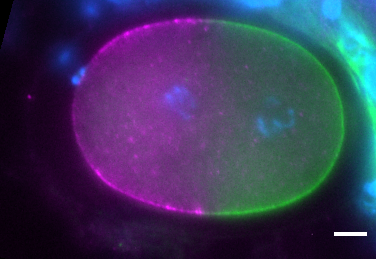Phosphatases are essential for cell polarity
Cell polarity is a characteristic of many cells and it is important for their function. For example, loss of cell polarity is observed in cancer cells and correlates with their ability to invade tissues. In many cells, polarity relies on the asymmetric distribution of the conserved PAR (PARtitioning defective) proteins, which depends on phosphorylation/dephosphorylation reactions. While phosphorylation reactions by kinases important for cell polarity have been extensively studied, the role of phosphatases, enzymes responsible for dephosphorylation is less well characterized.
In their recent study published in the Journal of Cell Biology, Ida Calvi and other members of Pr. Monica Gotta laboratory have used one-cell embryos of a nematode called Caenorhabditis elegans as a model system to show that phosphatases are required for polarity establishment. They found that the absence of two specific and conserved phosphatases, called GSP-1 and GSP-2, hinders the normal localization of the PAR-2 protein on the posterior side of the cell (in green in the microscopy image below), and thus blocks the proper establishment of cell polarity. Altogether, their recent experiments demonstrate that cell polarity is not only a matter of kinases, and that phosphatases also play a crucial role in establishing and maintaining cell polarity.

Cell polarity of a wild type one-cell C. elegans embryo with the PAR-6 protein on the anterior side (in magenta) and the PAR-2 protein on the posterior side (in green). Scale bar: 5μm. © Laboratory of Pr. Monica Gotta, UNIGE
27 Sept 2022
